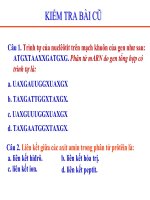Operons và quá trình điều hòa hoạt động của gen
Bạn đang xem bản rút gọn của tài liệu. Xem và tải ngay bản đầy đủ của tài liệu tại đây (1.11 MB, 24 trang )
Chapter 18 - Operons
Control of Gene Expression in
Prokaryotes
Sample Pathway for Control of
Tryptophan (trp) Expression
Gene 1
Gene 2
Gene 3
Gene 4
Gene 5
transcription
translation
Enzyme 1
Enzyme 2
Enzyme 3
Enzyme 4
Enzyme 5
Each enzyme
catalyzes the
next series of
reactions
necessary for
tryptophan
production
Promotor (RNA
polymerase binding
site)
DNA
mRNA
(transcription unit)
2 Negative Feedback
shut-off systems
trp
Basic Vocabulary
mRNA Transcription Unit:
- grouping of mRNA genes with related
function
- 2 advantages ~
1. organization
2. easy regulation – one “on/off” switch
can be used to control an entire cluster
of related genes
Basic Vocabulary
Operon:
- an entire gene-regulating system in
PROKARYOTES, which includes the
operator, promotor, and all corresponding
genes
Basic Vocabulary
Operator:
- “on-off” switch to genes
- controls the access of RNA polymerase
to genes
- found within the promotor region or
between the promoter and gene-encoding
regions
Let’s take a closer
look at the tryptophan
(trp) operon…an
example of a
“repressor” system
Overview of Repressor Trp Operon
Components
r. Trp
Repressor
Gene
(always
“on”)
promotor
rp. RNA Pol.
binding site
o. Operator
r. rp. o. Gene 1
5 Genes needed for
tryptophan production
mRNA transcription unit
Enz 1 Enz 2 Enz 3 Enz 4 Enz 5
Gene 1Gene 3 Gene 4 Gene 5
trp
mRNA for trp
repressor
Trp repressor protein
translated in its
“inactive” form
RNA polymerase
Trp operon controls the production
of the amino acid tryptophan
How is the trp operon turned off
once enough trp is made?
Trp repressor
gene
RNA pol
binding site
operator
Increased concentration of trp (co-
repressor) increases chances of trp
binding to allosteric site of inactive trp
repressor
Inactive trp
repressor
protein
trp
trp
trp
trp
trp
How is the trp operon turned off
once enough trp is made?
Active trp repressor
can now bind to
operator
RNA polymerse,
therefore is
physically blocked
from transcribing
genes for trp
Why is this a repressor system?
The trp operon is a repressor operon, meaning
gene expression of the operon is repressed
by the presence of the co-repressor,
tryptophan.
Watch this animation to fully
understand and review this operon,
then take the on-line quiz together
as a class
/>nt/chp13/1302002.html
Overview of Inducible Lac Operon
The Lac operon controls the production of
the ß-galactosidase, an enzyme that
catalyzes the hydrolysis (break-down) of
lactose into glucose and galactose.
This is an inducible operon, meaning gene
expression ß-galactosidase is stimulated
by the presence of an co-inducer, lactose.
Inducible Lac operon
I. crp. rp. o.
I. Lac
Inducer
crp: helps
RNA pol.
to bind
rp: RNA
pol.binding
site
o. operator
promotor
Genes that
promote ß-
galactosidase
production
mRNA for
inducer
protein
inducer
protein in
“active”
form
RNA pol.
blocked from ß-
galactosidase
transcription
without lactose
co-inducer
TWO regulatory mechanisms used
to turn on lac operon
1) Presence of lactose as a co-inducer
** reason?
ß-galactosidase is not needed unless lactose
needs to be broken down
2) Low amounts of glucose
** reason?
Recall that lactose breaks down into glucose and
galactose. Low glucose levels signals the cell
for more lactose to be broken down.
Both conditions must be met for the lac operon to turn on.
TWO regulatory mechanisms used
to turn on lac operon
1) Allolactose co-
inducer attaches to
allosteric site of inducer
protein, inactivating it
AlloLactose
2. cAMP attaches to CRP
transcription factor when
glucose is scarce
CRP Transcription
Factor
cAMP
RNA polymerase can bind
only with the help of CRP
transcription factor
RNA pol.
Lac Operon Animation
Watch this animation to fully understand and
review the lac operon!
/>0/bio27.swf
How are genes controlled in
eukaryotes?
1) Regulation of Chromatin Structure
2) Pre and post Transcriptional Regulation
3) Pre and Post Translational Regulation
Regulation of Chromatin Structure
N-terminus (amino group) of histone proteins face outwards
from nucleosome
Tails are thus able to be modified chemically
Regulation of Chromatin Structure
•
Histone Acetylation – neutralizes (+) charges on
tails, which prevents binding to adjacent
nucleosome loose chromatin structure results,
allowing for increased transcription
•
Methylation Promotes condensation
•
Phosphorylation can prevent condensation, if
phosphorylation is adjacent to methyl group
Pre-Transcriptional Regulation
•
Similar to methods used in bacterial
operons, using proteins that inhibit or
promote binding of RNA pol.
–
Distal and Proximal Control Elements
–
Proteins involved include:
•
Transcription factors
•
Activators
•
Mediator Proteins
Post-Transcriptional Regulation
RNA Processing
– differential/alternative splicing can produce
different 2
0
mRNA transcript
Differential splicing redefines
which RNA segments are
considered introns and which
are exons
Post-Transcriptional Regulation
•
Time of mRNA degradation can vary
Pre-Translational Regulation
Initiation of Translation
- can be blocked by regulatory proteins
that prevent ribosome binding
- shortened polyA tails in mRNA prevents
translation (polyA tails can be added
during appropriate time)
- global regulatory control of all mRNAs in
cell
Post-Translational Regulation
•
During protein processing, folding
•
Timing of protein degredation can vary
•
Proteasomes degrade proteins that are
tagged by ubiquitine molecules









